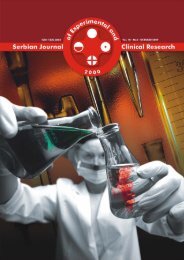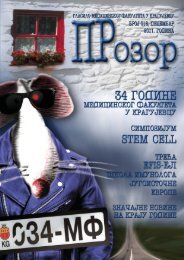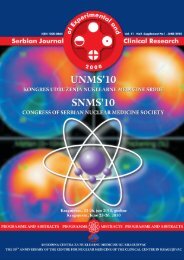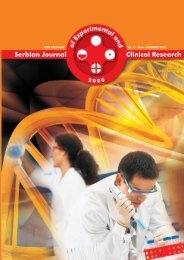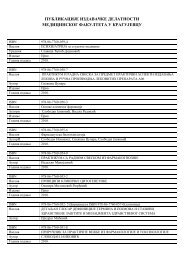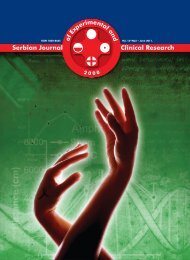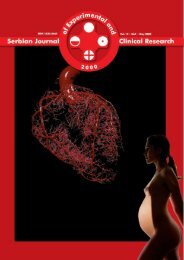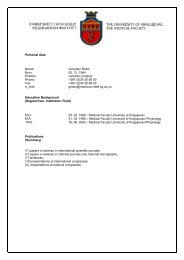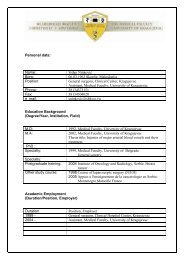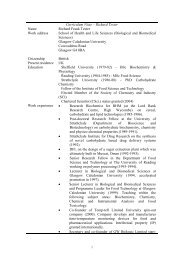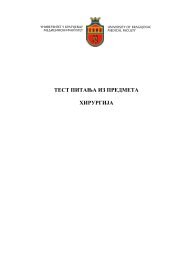neurotoxicity and mechanisms of induced hyperexcitability
neurotoxicity and mechanisms of induced hyperexcitability
neurotoxicity and mechanisms of induced hyperexcitability
Create successful ePaper yourself
Turn your PDF publications into a flip-book with our unique Google optimized e-Paper software.
BACKGROUNDWithin the past four decades, investigators worldwidehave established that the amino acid homocysteine (Hcy)is a novel <strong>and</strong> independent risk factor for arteriosclerosis.In addition, Hcy is a vasotoxic <strong>and</strong> neurotoxic agent thatinterferes with the fundamental biological processes commonto all living cells. Therefore, it has also been termedthe “cholesterol <strong>of</strong> the 21 st century.”Metabolism <strong>of</strong> homocysteine is coordinately regulatedto maintain a balance between remethylation <strong>and</strong> transsulfurationpathways, which are critical to maintaininglow levels <strong>of</strong> this potentially cytotoxic sulphur containingamino acid (1). Homocysteine belongs to a group <strong>of</strong> moleculesknown as cellular thiols <strong>and</strong> is considered a “bad”thiol. Glutathione <strong>and</strong> cysteine, the most abundant cellularthiols, are considered to be “good” thiols (2). In the methylationpathway that occurs in all tissues, homocysteineacquires a methyl group to form methionine in a vitaminB12 dependent reaction, which is catalysed by methioninesynthase. The second substrate required by methioninesynthase is 5-methyltetrahydr<strong>of</strong>olate, which is formed bythe reduction <strong>of</strong> 5,10-methylenetetrahydr<strong>of</strong>olate. This reactionis catalysed by the enzyme methylenetetrahydr<strong>of</strong>olatereductase (MTHFR). The TT genotype <strong>of</strong> this enzymecauses thermolability <strong>and</strong> reduces enzyme activity, whichimpairs the formation <strong>of</strong> 5-methyltetrahydr<strong>of</strong>olate. Thisreduced enzyme activity explains why this genotype is associatedwith increased Hcy levels when the folate status isrelatively low. However, liver, kidney <strong>and</strong> the lens <strong>of</strong> the eyehave the ability to convert Hcy to L-methionine througha vitamin B12-independent reaction catalysed by betaine-Hcy S-methyltransferase (BHMT). The CNS lacks BHMT<strong>and</strong> it is completely dependent on the folate <strong>and</strong> vitaminB12 pathway for the conversion <strong>of</strong> Hcy to L-methionine.Homocysteine condenses with serine to form cystathioninein an irreversible reaction catalysed by the B6containing enzyme cystathionine beta-synthase, which isknown as the transsulfuration pathway. Hcy catabolism requiresvitamin B6 <strong>and</strong> as a consequence, alterations in folicacid <strong>and</strong> B vitamin status impairs Hcy biotransformation.These alterations result in the synthesis <strong>of</strong> cysteine, taurine<strong>and</strong> inorganic sulphates that are excreted in urine.Elevation <strong>of</strong> homocysteine levels is known to lead to themetabolic conversion <strong>and</strong> inadvertent elevation <strong>of</strong> homocysteinethiolactone, which is a reactive thioester representingless than 1% <strong>of</strong> total plasma homocysteine. In all cell types,from bacteria to human, homocysteine is metabolised to homocysteinethiolactone by methionyl-tRNA synthetase (3).Homocysteine thiolactone causes lethality, growth retardation,blisters <strong>and</strong> abnormalities in somite development by oxidativestress, which is one <strong>of</strong> important <strong>mechanisms</strong> for its toxicity toneuronal cells (4). The highly reactive <strong>and</strong> toxic homocysteinemetabolite, homocysteine thiolactone, can be produced in twosteps by enzymatic <strong>and</strong>/or non-enzymatic reactions in bloodserum. The ability to detoxify or eliminate homocysteine thiolactoneis essential for biological integrity (3, 4).Total plasma Hcy (tHcy) consists <strong>of</strong> a pool <strong>of</strong> free homocysteine,homocystine, Hcy-S-S-Cys disulphide, proteinbound N- <strong>and</strong> S-linked Hcy as well as their oxidisedforms <strong>and</strong> Hcy-thiolactone (5-7). Under physiologicalconditions, less than 1% <strong>of</strong> the total Hcy is present in afree reduced form. Approximately 10–20% <strong>of</strong> total Hcy ispresent in different oxidised forms, such as Hcy-Cys <strong>and</strong>homocystine, which is a Hcy dimer. Plasma tHcy levels areaffected by genetic, physiologic (age <strong>and</strong> sex) <strong>and</strong> lifestylefactors as well as various pathologic conditions (5, 6, 8).Hyperhomocysteinemia is defined as an elevated plasmatotal homocysteine (tHcy) concentration (>15 μM).Elevated tHcy is a recognised risk factor for cardiovasculardisease (9) <strong>and</strong> has been linked to neurological diseasesduring aging, such as cognitive declines, cerebrovasculardisease <strong>and</strong> stroke, vascular dementia <strong>and</strong> Alzheimer’sdisease. In addition, elevated tHcy levels are linked withpathological brain functioning, such as mental retardation,depression, schizophrenia <strong>and</strong> memory impairment.Hcy is also a pro-thrombotic <strong>and</strong> pro-inflammatory factor,vasodilatation impairing substance <strong>and</strong> an endoplasmaticreticulum stress inducer (10, 11).Mitrovic et al. (12) evaluated total plasma homocysteinein patients with angiographically confirmed coronary arterydisease. In addition, they investigated the effects <strong>of</strong>homocysteine lowering therapy on endothelial function,carotid wall thickness <strong>and</strong> myocardial perfusion. Theirstudy found that homocysteine levels decreased significantly(34%) with folic acid therapy <strong>and</strong> that endotheliumfunction improved by 27% with this treatment. However,carotid structure <strong>and</strong> myocardial perfusion did not showany significant improvement in patients with confirmedcoronary artery disease (13). Djuric et al. (14, 15) also investigatedthe link between homocysteine <strong>and</strong> folic acid,demonstrated folic acid <strong>induced</strong> coronary vasodilation<strong>and</strong> decreased oxidative stress in the isolated rat heart.HOMOCYSTEINE AND NEUROTOXICITYDespite several theories, a complete underst<strong>and</strong>ing <strong>of</strong>Hcy toxicity remains unclear. In particular, the hypothesisthat relates homocysteine to CNS dysfunction by way <strong>of</strong>overt <strong>neurotoxicity</strong> is based on the neuroactive properties <strong>of</strong>homocysteine. Elucidating the link between homocysteine<strong>and</strong> CNS dysfunction is vital for improving the treatment<strong>of</strong> homocysteine related CNS disorders. Hcy adversely affectsbrain functioning (i.e., mental retardation, dementia<strong>and</strong> memory impairment) <strong>and</strong> high tissue concentrationscause oxidative stress <strong>and</strong> excitotoxicity in neurons (16).When these symptoms are combined with homocystinuria,patients <strong>of</strong>ten present with convulsions (17). These studiesprovide evidence for a complex <strong>and</strong> multifaced relationshipbetween homocysteinemia <strong>and</strong> CNS disorders. Hcy isan endogenous compound that is neurotoxic at supraphysiologicalconcentrations <strong>and</strong> induces neuronal damage <strong>and</strong>cell loss through excitotoxicity <strong>and</strong> apoptosis. These CNS4



